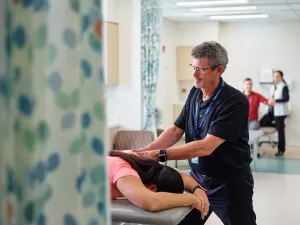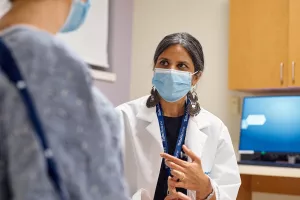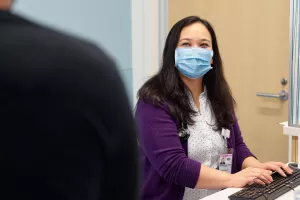Spinal stenosis is where the spinal canal (the hollow part of the spine) narrows, which puts pressure on the spinal cord and the nerves in and around the spine. While not everyone with spinal stenosis experiences symptoms, for those who do, we can help you treat any pain, numbness and weakness you experience.
How can I find relief from spinal stenosis?
Do you ever experience neck, back or leg pain while moving around that seems to disappear when you relax? If so, you may be living with spinal stenosis. As we age, our spinal discs can lose their elasticity and start to shrink, which causes the spinal canal to narrow. That's why spinal stenosis is more common in people over age 50.
Spinal stenosis can't be cured, but our team of spinal specialists can help you manage it with a treatment path that's uniquely you. From over-the-counter medications and physical therapy to surgery, we've always got your back.

Treatments
We’ll map a personalized treatment path based on your age, type of pain and mobility levels. That may mean a combination of at-home remedies like cold and heat therapy along with physical therapy. We may also explore surgery if the pain becomes too much to bear.
Depending on your condition, your doctor may first recommend treating spinal stenosis with mix of cold and heat therapy. Follow these tips for the most relief with cold therapy:
- When applying an ice pack or other form of cold therapy, make sure to place a cloth between your skin and anything frozen to reduce the chance of ice burns.
- Be sure to only apply cold therapy for 20 minutes at a time, no more than 10 times per day.
After the swelling has subsided, heat therapy can reduce pain and stiffness. There are 2 types of heat therapy: dry and moist.
- Dry heat therapy includes electric heating pads and hot water bottles. These methods are often faster and easier to apply.
- Moist heat therapy includes hot baths, steamed towels or moist heating packs.
Remember to be careful when using heat therapy, and experiment with both heat and cold therapies to find out which works best for you.
Your doctor may recommend over-the-counter medications to help with spinal stenosis discomfort. You can pick up these medications at your local pharmacy or grocery store without needing a formal prescription:
- Non-steroidal anti-inflammatory drugs (NSAIDs) like aspirin or ibuprofen help with back pain, neck pain and inflammation. Remember to read the medication labels and to not take more medicine than directed.
- Topical rubs are available over the counter and can mimic the sensation of heat and cold therapy.
- Over-the-counter muscle relaxants like methocarbamol or cyclobenzaprine can prevent muscle spasms caused by spinal stenosis.
If at-home remedies aren’t helping ease your spinal stenosis pain, physical therapy may be the right treatment for you. Your physical therapist will work with you to stretch and strengthen your back and neck muscles and teach you how to keep up with your regimen at home.
Spine surgery can offer you the relief you need from spinal stenosis. At the same time, it can feel like a daunting undertaking. That's why we first explore nonsurgical treatment options before walking you through surgical options.
When you and your doctor agree this is the next best step in your care plan, we'll connect you to some of our brightest minds in neurosurgery and orthopedics. We specialize in minimally invasive procedures that bring you the relief you deserve and shorter recovery times.
Decompression surgery helps give your spinal area some breathing room by removing the vertebrae, ligaments or other tissue that’s causing you pain. Whenever possible, we opt for minimally invasive decompression surgeries, which means we can perform the procedure with an incision no bigger than a couple of inches.
During a spinal fusion surgery, we’ll reconnect unstable vertebrae using metal screws and rods, which work like an internal brace to keep the bones in your back in the correct position.

From regular office visits to inpatient stays, find the healthcare you need and deserve close to home.

Meet the doctors and care team devoted to supporting you every step of the way along your path to better health.